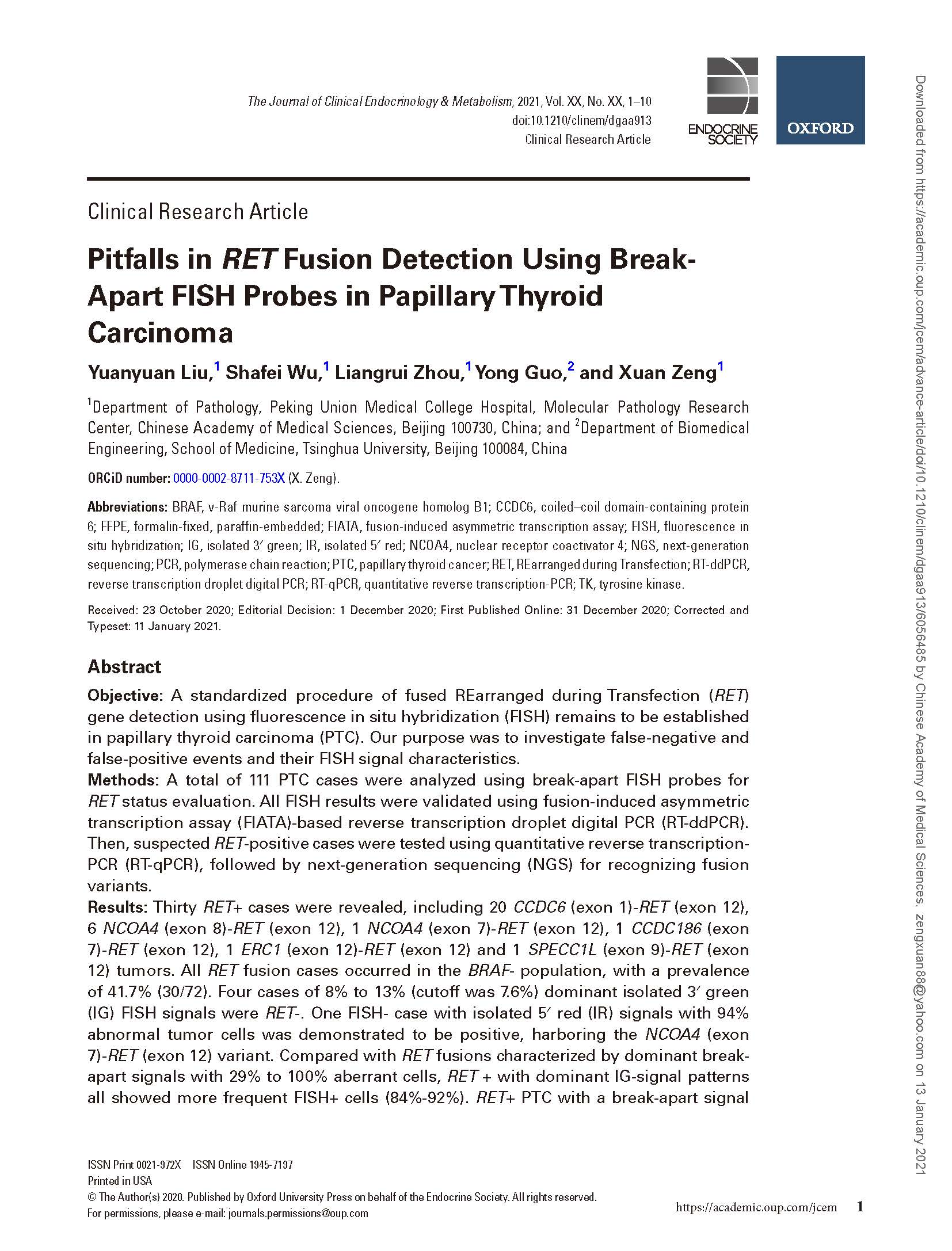Pitfalls in RET Fusion Detection Using BreakApart FISH Probes in Papillary Thyroid Carcinoma
release date:2021-01-11

Objective: A standardized procedure of fused REarranged during Transfection (RET) gene detection using fluorescence in situ hybridization (FISH) remains to be established in papillary thyroid carcinoma (PTC). Our purpose was to investigate false-negative and false-positive events and their FISH signal characteristics.
Methods: A total of 111 PTC cases were analyzed using break-apart FISH probes for RET status evaluation. All FISH results were validated using fusion-induced asymmetric transcription assay (FIATA)-based reverse transcription droplet digital PCR (RT-ddPCR). Then, suspected RET-positive cases were tested using quantitative reverse transcription-PCR (RT-qPCR), followed by next-generation sequencing (NGS) for recognizing fusion variants.
Results: Thirty RET+ cases were revealed, including 20 CCDC6 (exon 1)-RET (exon 12), 6 NCOA4 (exon 8)-RET (exon 12), 1 NCOA4 (exon 7)-RET (exon 12), 1 CCDC186 (exon 7)-RET (exon 12), 1 ERC1 (exon 12)-RET (exon 12) and 1 SPECC1L (exon 9)-RET (exon 12) tumors. All RET fusion cases occurred in the BRAF- population, with a prevalence of 41.7% (30/72). Four cases of 8% to 13% (cutoff was 7.6%) dominant isolated 3′ green (IG) FISH signals were RET-. One FISH- case with isolated 5′ red (IR) signals with 94%abnormal tumor cells was demonstrated to be positive, harboring the NCOA4 (exon 7)-RET (exon 12) variant. Compared with RET fusions characterized by dominant break-apart signals with 29% to 100% aberrant cells, RET + with dominant IG-signal patterns all showed more frequent FISH+ cells (84%-92%). RET+ PTC with a break-apart signal pattern was more frequently found in unifocal lesions than in multifocal/bilateral tumors (P = 0.049).
Conclusions: A false-positive or false-negative event may exist for RET status detection in PTCs using the traditional FISH scoring method with break-apart probes.
Key Words: papillary thyroid cancer, RET, FISH, rearrangement, false-negative, false-positive
See all: https://doi.org/10.1210/clinem/dgaa913
 Objective: A standardized procedure of fused REarranged during Transfection (RET) gene detection using fluorescence in situ hybridization (FISH) remains to be established in papillary thyroid carcinoma (PTC). Our purpose was to investigate false-negative and false-positive events and their FISH signal characteristics.
Objective: A standardized procedure of fused REarranged during Transfection (RET) gene detection using fluorescence in situ hybridization (FISH) remains to be established in papillary thyroid carcinoma (PTC). Our purpose was to investigate false-negative and false-positive events and their FISH signal characteristics.